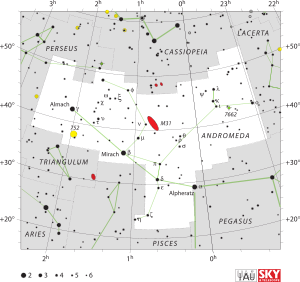Xi Andromedae
Xi Andromedae (ξ Andromedae, abbreviated Xi And, ξ And), officially named Adhil /əˈdɪl/,[7][8] is a solitary[3] star in the northern constellation of Andromeda. It has an apparent magnitude of +4.9.[2] Based on parallax measurements obtained during the Hipparcos mission, it lies at a distance of roughly 214 light-years (66 parsecs) from the Sun.[1]
 | |
| Observation data Epoch J2000 Equinox J2000 | |
|---|---|
| Constellation | Andromeda |
| Right ascension | 01h 22m 20.41924s[1] |
| Declination | +45° 31′ 43.6003″[1] |
| Apparent magnitude (V) | +4.90[2] |
| Characteristics | |
| Spectral type | K0 IIIb[3] |
| U−B color index | +0.98[2] |
| B−V color index | +1.08[2] |
| Astrometry | |
| Radial velocity (Rv) | –12.59[4] km/s |
| Proper motion (μ) | RA: +31.45[1] mas/yr Dec.: +8.83[1] mas/yr |
| Parallax (π) | 15.21 ± 0.28[1] mas |
| Distance | 214 ± 4 ly (66 ± 1 pc) |
| Absolute magnitude (MV) | 0.550[5] |
| Details | |
| Mass | 2.5[5] M☉ |
| Radius | 10[6] R☉ |
| Luminosity | 45.7[6] L☉ |
| Surface gravity (log g) | 2.8[6] cgs |
| Temperature | 4,656[6] K |
| Metallicity [Fe/H] | +0.03[6] dex |
| Rotational velocity (v sin i) | 0.0[6] km/s |
| Other designations | |
| Database references | |
| SIMBAD | data |
Nomenclature
ξ Andromedae (Latinised to Xi Andromedae) is the star's Bayer designation. It also bears the Flamsteed designation 46 Andromedae. Johann Bayer labeled this star "ξ" in his Uranometria. The star appeared in John Flamsteed's Atlas Coelestis, but was unlabeled. It was later designated as 46 And by Jérôme Lalande. The label "ξ" was used in Atlas Coelestis, apparently erroneously, for what Bayer had labeled "A" (Bayer's A Andromedae has the Flamsteed designation 49 Andromedae).
It bore the traditional name Adhil, which is derived from the Arabic الذيل að-ðayl "the train" (lit. "the tail"). In 2016, the International Astronomical Union organized a Working Group on Star Names (WGSN)[9] to catalogue and standardize proper names for stars. The WGSN approved the name Adhil for this star on 21 August 2016 and it is now so included in the List of IAU-approved Star Names.[8]
Properties
This star is a red clump giant star that has begun generating energy through the fusion of helium at its core, having passed through the red giant branch of its evolution.[5] It has a stellar classification of K0 IIIb,[3] with 2.5[5] times the mass of the Sun and 10[6] times the Sun's radius. Xi Andromedae is emitting nearly 46[6] times as much luminosity as the Sun from its outer envelope at an effective temperature of 4,656 K,[6] giving it the orange-hued glow of a K-type star. It has no measurable projected rotational velocity,[6] although this may simply mean that the star's pole of rotation is facing in the general direction of the Earth.
References
- van Leeuwen, F. (November 2007), "Validation of the new Hipparcos reduction", Astronomy and Astrophysics, 474 (2): 653–664, arXiv:0708.1752, Bibcode:2007A&A...474..653V, doi:10.1051/0004-6361:20078357.
- Johnson, H. L.; et al. (1966). "UBVRIJKL photometry of the bright stars". Communications of the Lunar and Planetary Laboratory. 4 (99). Bibcode:1966CoLPL...4...99J.
- Eggleton, P. P.; Tokovinin, A. A. (September 2008). "A catalogue of multiplicity among bright stellar systems". Monthly Notices of the Royal Astronomical Society. 389 (2): 869–879. arXiv:0806.2878. Bibcode:2008MNRAS.389..869E. doi:10.1111/j.1365-2966.2008.13596.x. Note that the 1991 Bright Star Catalogue has listed this as a spectroscopic binary with a period of 17.7673d.
- Famaey, B.; et al. (January 2005), "Local kinematics of K and M giants from CORAVEL/Hipparcos/Tycho-2 data. Revisiting the concept of superclusters", Astronomy and Astrophysics, 430 (1): 165–186, arXiv:astro-ph/0409579, Bibcode:2005A&A...430..165F, doi:10.1051/0004-6361:20041272.
- Mishenina, T. V.; et al. (September 2006), "Elemental abundances in the atmosphere of clump giants", Astronomy and Astrophysics, 456 (3): 1109–1120, arXiv:astro-ph/0605615, Bibcode:2006A&A...456.1109M, doi:10.1051/0004-6361:20065141
- Massarotti, Alessandro; et al. (January 2008), "Rotational and Radial Velocities for a Sample of 761 HIPPARCOS Giants and the Role of Binarity", The Astronomical Journal, 135 (1): 209–231, Bibcode:2008AJ....135..209M, doi:10.1088/0004-6256/135/1/209.
- Kunitzsch, Paul; Smart, Tim (2006). A Dictionary of Modern star Names: A Short Guide to 254 Star Names and Their Derivations (2nd rev. ed.). Cambridge, Massachusetts: Sky Pub. ISBN 978-1-931559-44-7.
- "Naming Stars". IAU.org. Retrieved 18 June 2018.
- IAU Working Group on Star Names (WGSN), International Astronomical Union, retrieved 22 May 2016.